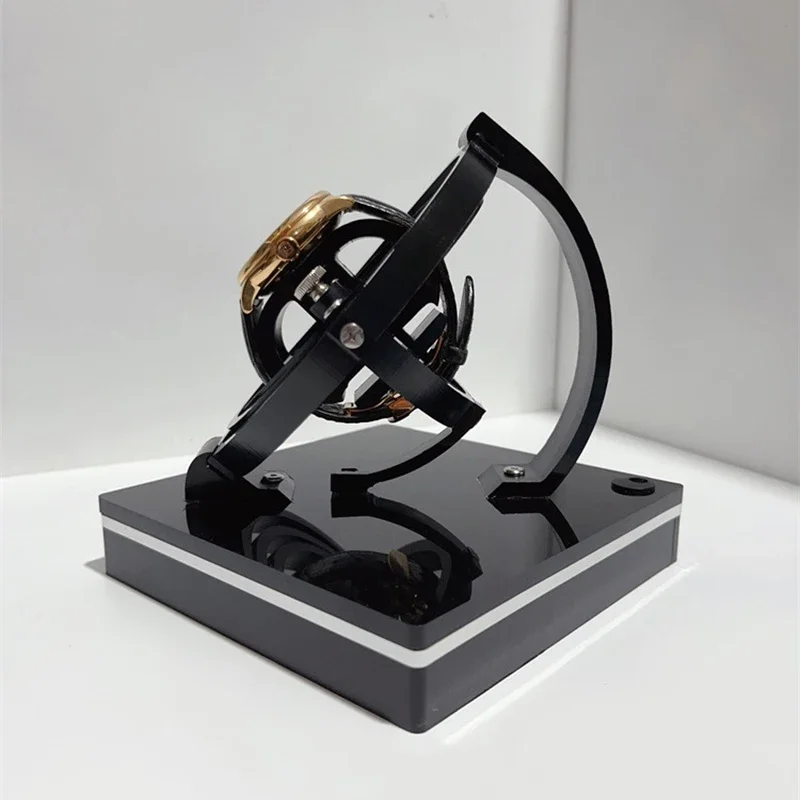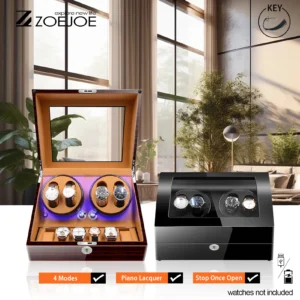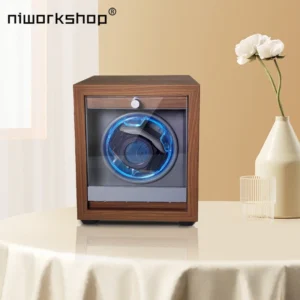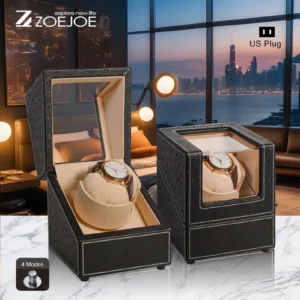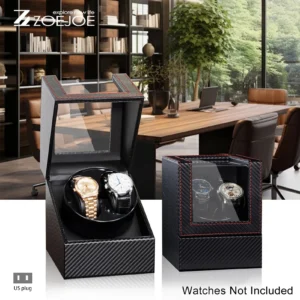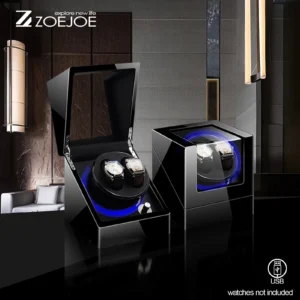Understanding Watch Winder Fundamentals
A watch winder is an essential device designed specifically for automatic watches, keeping them running when not worn by mimicking the natural wrist movements that wind the watch. Automatic watches contain a weighted rotor mechanism that rotates as you move your wrist, transferring energy to the mainspring that powers the watch.
Two critical settings determine how effectively a watch winder performs:
- Turns Per Day (TPD): The number of complete rotations the winder performs in a 24-hour period
- Rotation Direction: Whether the winder turns clockwise, counterclockwise, or both directions (bidirectional)
Using the correct settings isn’t just about convenience—it’s crucial for maintaining your watch’s health and accuracy. Different watch manufacturers design their movements with specific winding requirements, and meeting these requirements ensures optimal performance.
The rotor in an automatic watch typically needs to make a certain number of rotations to fully wind the mainspring. For example, some watches might require 650 rotations daily while others need over 1,000 to maintain proper timekeeping.
Proper watch collection storage planning includes considering how your timepieces will remain wound when not worn. For collectors with multiple automatic watches, having access to quality watch winders with adjustable settings becomes an essential part of preservation strategy.
Why Correct Winder Settings Matter for Watch Longevity
Using the appropriate winder settings does more than just keep your watch running—it actively contributes to the longevity of your timepiece in several important ways:
- Optimal lubrication distribution: Proper rotation ensures the lubricating oils remain evenly distributed throughout the movement, preventing dry spots that can cause excessive friction and wear
- Prevention of mechanical stress: Correct TPD settings avoid overworking the winding mechanism or leaving the watch with insufficient power
- Accuracy preservation: Maintaining the proper tension in the mainspring helps the watch keep more consistent time
- Protection for complications: Watches with additional functions like perpetual calendars, moon phases, or chronographs especially benefit from continuous, properly regulated winding
When a watch receives insufficient winding, it may run for a while but gradually lose accuracy as the mainspring’s tension decreases. This can particularly affect watches with a power reserve under 48 hours.
Unlike manual winding—where enthusiastic overwinding by hand could potentially damage older timepieces—proper automatic winding through a correctly configured watch winder provides consistent, controlled energy to the movement.
Understanding the best automatic watch winder settings for your specific timepieces helps ensure they receive exactly the right amount of winding—not too much, not too little—to maintain optimal performance for years to come.
Decoding Turns Per Day (TPD): The Essential Setting
Turns Per Day (TPD) represents the number of complete rotations a watch winder performs in a 24-hour period. This setting is the primary factor in determining whether your watch receives adequate winding.
Most automatic watches fall within these general TPD ranges:
– Standard movements: 650-900 TPD
– High-beat movements: 800-1000+ TPD
– Watches with extended power reserves: Often require fewer TPD
The engineering design of each movement directly influences its TPD requirement. Factors including mainspring size, power reserve capacity, and winding efficiency all play a role in determining the optimal TPD value.
Setting your TPD incorrectly can have consequences:
– Too low: The watch may stop or run inconsistently as the mainspring doesn’t receive enough tension
– Too high: While modern watches have protection against overwinding, excessive rotation creates unnecessary wear on components
High-frequency movements (those operating at 36,000 vibrations per hour rather than the more common 28,800 vph) typically need higher TPD settings because they use energy more rapidly, requiring more frequent winding to maintain optimal power.
For a deeper exploration of how TPD affects watch performance, the comprehensive guide on understanding TPD watch winders provides valuable insights into matching these settings to specific movement requirements.
Understanding Rotation Directions: Clockwise, Counter-Clockwise, and Bidirectional
Watch winders offer three rotation options that must be matched to your watch’s specific movement design:
- Clockwise (CW): The winder rotates only in a right-turning direction
- Counter-Clockwise (CCW): The winder rotates only in a left-turning direction
- Bidirectional (Bi): The winder alternates between clockwise and counter-clockwise rotation
These direction settings correspond to how a watch’s rotor transfers energy to the mainspring. Some watches wind efficiently in only one direction, while others can wind in both directions.
Unidirectional rotors (those that only wind the watch when spinning in one specific direction) require the matching rotation direction on your winder. Using the wrong direction means the watch receives no winding benefit at all, despite the winder appearing to function normally.
Bidirectional rotors capture energy when rotating in either direction, making bidirectional winding generally effective. However, many bidirectional rotors still have a preferred direction where they wind more efficiently.
When in doubt, bidirectional rotation is often the safest choice, as it ensures some winding occurs regardless of the movement design. However, for maximum efficiency with unidirectional rotors, matching the correct single direction provides optimal winding.
Quality automatic watch winders offer adjustable direction settings to accommodate different movement types within your collection.
The Comprehensive Watch Winder Settings Database
This database provides recommended settings for popular watch brands and movements. Remember that these are general guidelines—some variation may exist between specific models within the same brand.
| Brand | Movement/Model | Recommended TPD | Direction | Special Notes |
|---|---|---|---|---|
| Rolex | Modern Calibers | 650-800 | Bidirectional | Most efficient in clockwise |
| Rolex | Vintage Calibers | 650 | Bidirectional | Some pre-1990s models prefer clockwise |
| Omega | Co-Axial 8500/8900 | 800 | Bidirectional | Higher TPD for Chronometer models |
| Omega | 2500 Series | 650-800 | Bidirectional | – |
| TAG Heuer | Calibre 5/ETA 2824 | 800 | Bidirectional | – |
| Breitling | B01/B04 | 650-750 | Bidirectional | – |
| Breitling | Caliber 17/ETA 2824 | 800 | Bidirectional | – |
| Patek Philippe | Most Calibers | 800 | Bidirectional | Some vintage models need lower TPD |
| Audemars Piguet | 3120/3126/4302 | 800-950 | Bidirectional | – |
| IWC | Caliber 52000 family | 750-850 | Bidirectional | – |
| IWC | Caliber 82000 family | 750-850 | Bidirectional | Has Pellaton winding system |
| Seiko | 6R15/6R35 | 650-800 | Bidirectional | Most efficient in clockwise |
| Seiko | Spring Drive | 750 | Bidirectional | – |
| Tudor | MT56XX series | 650-750 | Bidirectional | – |
| Panerai | P.9000/P.9010 | 650-750 | Bidirectional | – |
| Jaeger-LeCoultre | Caliber 889/899 | 800 | Clockwise | Some models require specific direction |
| Vacheron Constantin | 1120/2450 | 800 | Bidirectional | – |
| ETA | 2824/2834/2836 | 650-800 | Bidirectional | Common in many brands |
| ETA | 2892 | 650-800 | Bidirectional | Common in many brands |
| Sellita | SW200/SW300 | 650-800 | Bidirectional | ETA clone movements |
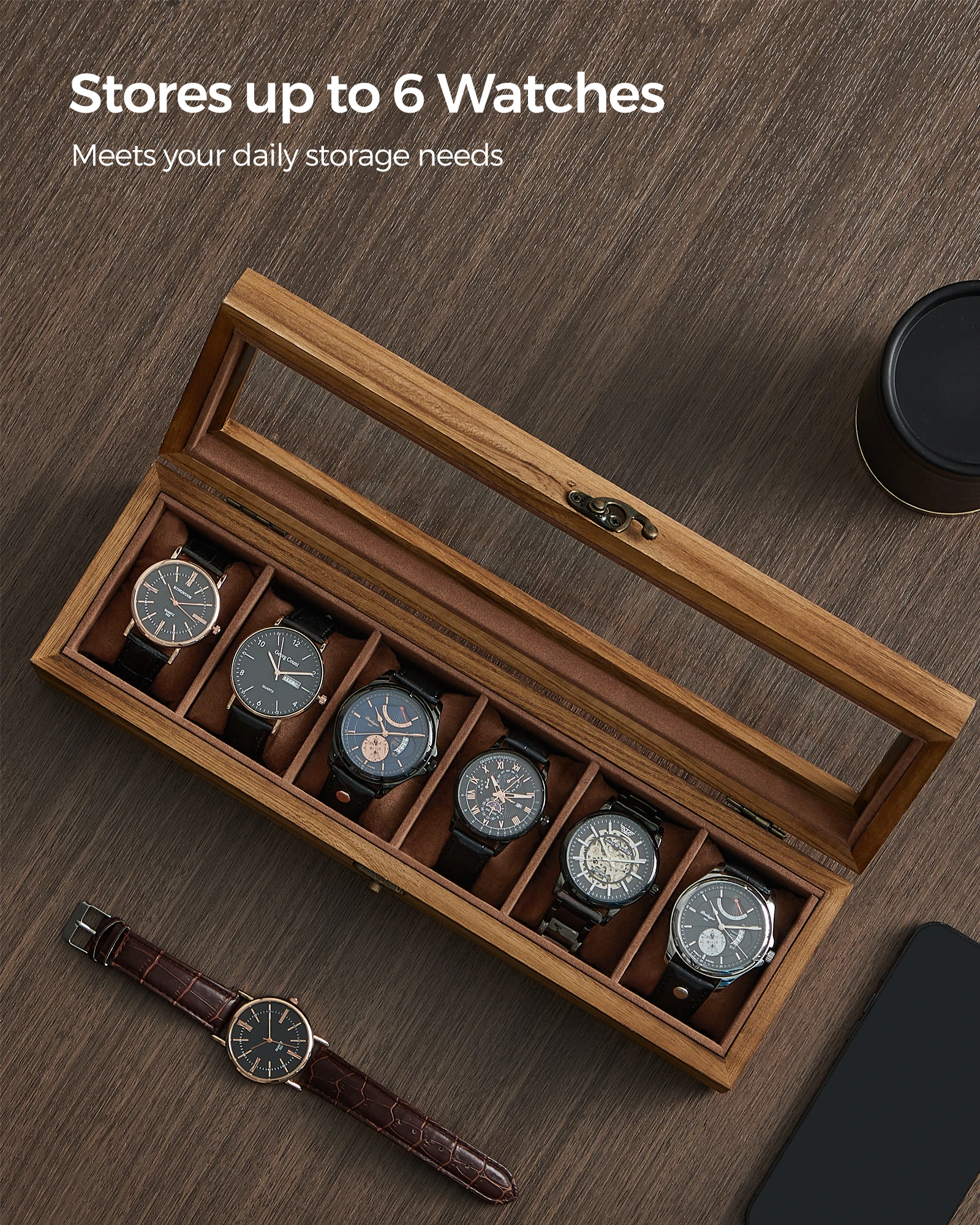
When using this database, first identify your watch brand, then find the specific movement if possible. If your exact model isn’t listed, the movement family often shares similar requirements.
For those interested in premium options to protect valuable timepieces, consider exploring luxury watch winders that offer precise control over these critical settings.
How to Determine Winder Settings for Unlisted Watches
If your specific watch model isn’t listed in the database above, don’t worry. Here’s a systematic approach to finding the right settings:
Identify your movement: Check your watch documentation or the manufacturer’s website. The model number or caliber information is often found on the case back or in the warranty papers.
Research similar movements: Many watches use movements from common families (like ETA, Sellita, or Miyota) with similar winding characteristics.
Contact the manufacturer: Reach out directly to the brand’s customer service for specific recommendations.
Use the trial and adjustment method:
– Start with a moderate TPD setting (around 750) and bidirectional rotation
– Place a fully wound watch on the winder for 24-48 hours
– Check if the watch maintains accurate time
– If the watch loses time, increase the TPD by 100-200
– If the watch performs well, you’ve found your settingMonitor performance: Once you’ve established settings, check your watch periodically for the first week to ensure it maintains proper time.
For watches with unknown movements, the bidirectional setting is generally the safest starting point as it ensures some winding occurs regardless of the rotor design. Most modern automatic watches respond well to TPD settings between 650-850.
Adjusting watch winder movements might require some patience, but taking the time to find the optimal settings will benefit your timepiece in the long run.
Setting Up Your Watch Correctly on a Winder
Properly preparing and positioning your watch on a winder ensures it receives the intended benefits:
Wind manually first: If your watch has stopped, manually wind it before placing it on the winder. For most watches, about 20-30 turns of the crown is sufficient to build an initial power reserve.
Set the correct time: Ensure your watch displays the correct time before placing it on the winder.
Program your winder settings:
– Input the recommended TPD for your specific watch
– Set the appropriate rotation direction
– If your winder has time cycle options, a standard setting of 8-12 hours on, 12-16 hours off often works wellSecure the watch properly:
– For leather straps: Close the buckle or clasp normally
– For metal bracelets: Adjust the winder cushion to provide a snug fit
– Ensure the watch head sits centered on the cushion or holderVerify operation: After setup, observe the winder briefly to confirm it’s rotating as expected and that the watch is secure.
Remember that different winder models have different programming interfaces, so consult your specific winder’s manual for detailed instructions.
Proper watch winder use is just one aspect of comprehensive watch collection organizing, which includes considerations for all your timepieces, both worn and stored.
Choosing the Right Watch Winder for Your Collection
Selecting the appropriate watch winder involves considering several key features:
- Adjustable TPD settings: Look for winders offering a range of at least 500-1200 TPD to accommodate different watches
- Multiple rotation modes: Ensure the winder provides clockwise, counter-clockwise, and bidirectional options
- Individual control: For multi-watch winders, separate motors and controls for each position allow optimal settings for different timepieces
- Quality construction: Smooth, quiet operation indicates good motor quality and reduces vibration exposure
- Power options: Consider whether battery operation, AC power, or both best suit your needs
Higher quality winders typically offer more precise TPD settings in smaller increments (e.g., steps of 100 TPD rather than preset options), allowing better customization for specific watches.
When building a collection of diverse timepieces, programmable individual settings become particularly valuable, as different watch brands may require significantly different winding parameters.

For those with particularly valuable timepieces, single watch winders provide dedicated winding with highly customizable settings for each individual watch.
Automatic Watch Winder, Luxury Watch Winder, Single Watch Box
$307.39 Select options This product has multiple variants. The options may be chosen on the product page4 Watch Winder, 6 Watch Box, Automatic Watch Winder
$512.31 Select options This product has multiple variants. The options may be chosen on the product pageAutomatic Watch Winder, Single Watch Winder, Wooden Watch Holder
$201.76 Select options This product has multiple variants. The options may be chosen on the product pageAutomatic Watch Winder, Leather Watch Travel Case, Single Watch Winder
$146.30 Select options This product has multiple variants. The options may be chosen on the product pageAutomatic Watch Winder, Double Watch Winder, Leather Watch Boxes
$147.60 Select options This product has multiple variants. The options may be chosen on the product pageAutomatic Watch Winder, Double Watch Winder
$206.18 Select options This product has multiple variants. The options may be chosen on the product page
Common Watch Winding Myths Debunked
Several misconceptions persist about watch winders and automatic watches. Let’s address some common myths:
Myth: Modern automatic watches can be overwound on a winder
Fact: Modern automatic watches contain a slipping mechanism in their mainspring design that prevents overwinding. Once the mainspring reaches full tension, additional winding has no effect.
Myth: Watch winders should run 24/7
Fact: Most watches benefit from periodic rest periods. Many experts recommend programming winders for 8-12 hours of operation followed by 12-16 hours of rest, mimicking natural wearing patterns.
Myth: Any watch winder will work for any automatic watch
Fact: Inexpensive winders with limited or preset settings can potentially damage watches by providing inadequate or excessive winding. Quality winders with adjustable settings are an investment in your timepiece’s longevity.
Myth: All automatic watches benefit equally from winders
Fact: Watches with complications (perpetual calendars, moon phases) benefit most from continuous running. Simple time-only watches can often be manually wound occasionally without the need for a winder.
Understanding these realities helps make informed decisions about watch storage ideas collectors should consider for their specific timepieces.
Troubleshooting Problems with Watch Winder Performance
Even with proper settings, you might encounter issues with your watch winder setup. Here’s how to diagnose and resolve common problems:
Problem: Watch stops despite being on the winder
Solution:
– Check that the TPD setting isn’t too low for your watch
– Ensure the winder is actually rotating (some have quiet motors)
– Verify the watch is properly secured and moving with the winder
– Increase TPD by 100-200 and monitor for improvement
Problem: Watch runs fast or inconsistently
Solution:
– Your TPD may be too high, creating excessive mainspring tension
– Try reducing TPD by 100-200
– Consider switching to an intermittent winding schedule rather than continuous
Problem: Watch needs manual adjustment despite winder use
Solution:
– Some watches with low power reserves may need higher TPD settings
– Check if your watch has a power reserve indicator and monitor its level
– Consider a winder with multiple daily winding cycles instead of one continuous session
When troubleshooting, make incremental adjustments and allow 2-3 days of observation before making additional changes. For collectors with multiple watches requiring different settings, double watch winders with independent motors allow customized solutions for different timepieces.
Special Considerations for Complications
Watches with additional functions beyond basic timekeeping—known as “complications”—often have special winding needs:
- Perpetual calendars benefit enormously from continuous winding, as letting them stop can require complex resetting procedures that might cost hundreds of dollars at a service center
- Moon phase displays maintain better accuracy when kept running continuously
- Annual calendars typically need resetting if allowed to stop, especially near month-end transitions
- Chronographs generally have the same winding requirements as the base movement but benefit from regular winding to maintain lubricant distribution in the additional mechanisms
The cost-benefit calculation strongly favors winders for complicated watches. The convenience of not having to reset complex functions combined with the protection of delicate mechanisms justifies the investment in quality winders with precise settings.
Even with a winder, some complications (like those that track leap years) may occasionally require manual adjustment, but the frequency is significantly reduced compared to watches that regularly stop.
Can All Automatic Watches Use Winders? Important Exceptions
While most modern automatic watches are compatible with winders, there are important exceptions to consider:
- Vintage watches (particularly pre-1960s) may have more delicate winding mechanisms not designed for continuous operation
- Watches with unique winding systems like Seiko Kinetic (which uses a capacitor rather than a mainspring) require special consideration
- Extremely high power reserve watches (7+ days) may need custom winding cycles
- Watches with known movement issues might be better hand-wound until serviced
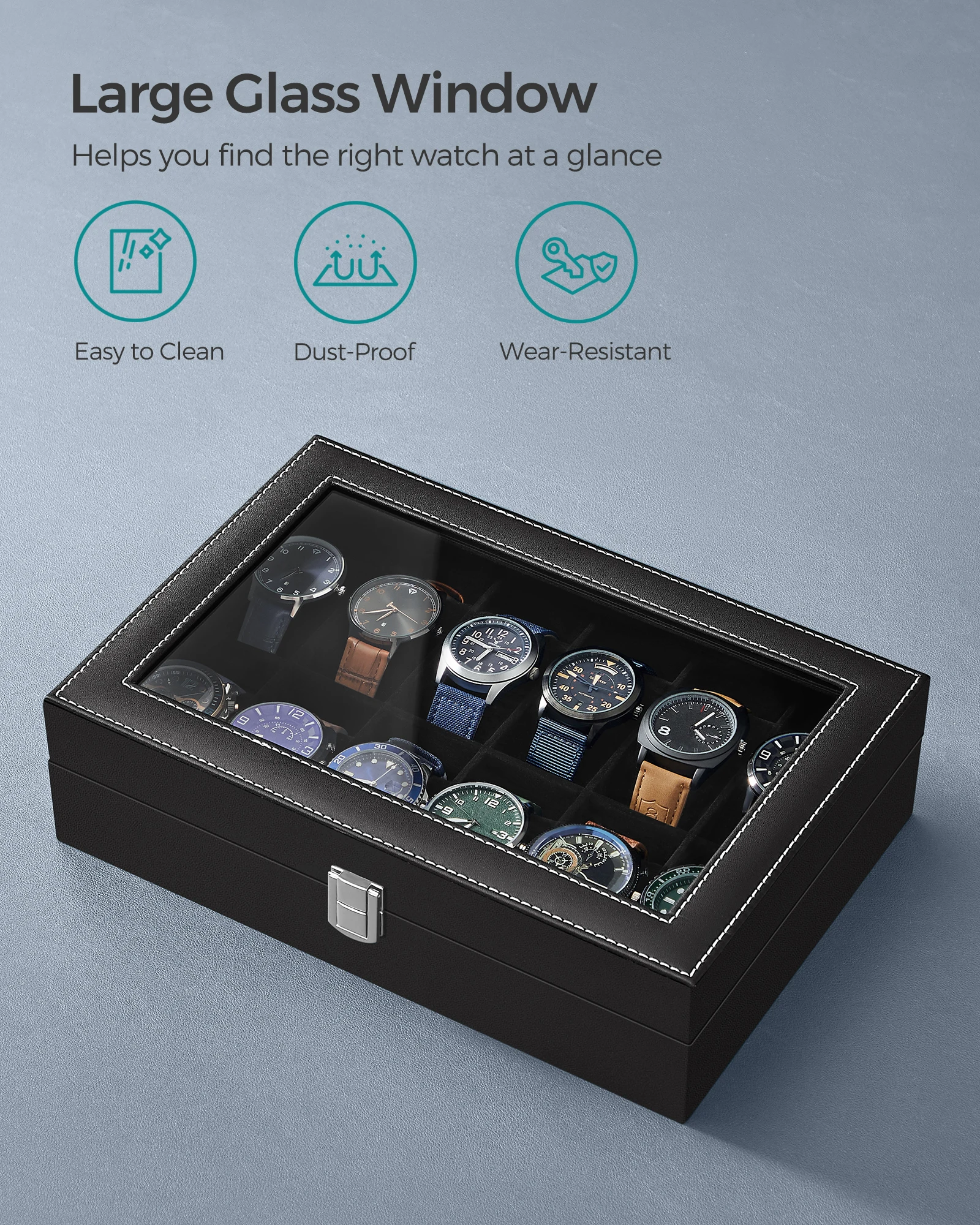
For timepieces that aren’t suitable for winders, exploring alternative types of watch storage becomes essential for proper preservation.
Frequently Asked Questions About Watch Winder Settings
Is it bad to keep my watch on a winder all the time?
Most modern watches can safely remain on a winder continuously, especially with intermittent winding cycles. However, watches worn regularly may not need constant winder use.
Do I need a different winder for each watch brand?
No, but you need a winder with adjustable settings that can accommodate the different requirements of various brands and movements.
How do I know if my winder is actually working properly?
Monitor your watch’s accuracy and power reserve. A properly wound watch should maintain consistent timekeeping and not stop overnight.
Should I still manually wind my watch occasionally?
It’s not necessary for most modern watches, but some collectors prefer to maintain the habit of occasional manual winding even when using a winder.
Can incorrect winder settings damage my watch?
While modern watches have safeguards against overwinding, consistently incorrect settings can cause unnecessary wear on the winding mechanism over time.
For collectors with multiple timepieces requiring different settings, 4-watch winders offer the flexibility to store and maintain several pieces with individualized programs.
Best Practices for Winder Maintenance and Care
Your watch winder itself requires proper maintenance to ensure it continues to care for your timepieces effectively:
- Clean regularly: Dust the exterior and winding cushions monthly using a soft, lint-free cloth
- Inspect cushions: Check for wear or compression every 6 months, replacing them if they no longer hold watches securely
- Verify rotation: Periodically check that the winder completes full rotations without hesitation or unusual noises
- Battery maintenance: For battery-operated winders, replace batteries before they fully deplete to avoid potential motor issues
- Proper placement: Position your winder away from:
- Direct sunlight (can affect both the winder and watches)
- Strong magnetic fields (speakers, some electronics)
- High humidity areas
- Areas with temperature fluctuations
For AC-powered winders, consider using a surge protector to prevent motor damage during power fluctuations. Battery-operated winders offer placement flexibility but require more frequent maintenance.
Regular checks ensure your winder continues to provide the proper care for your valuable timepieces, maintaining both their function and value for years to come.

